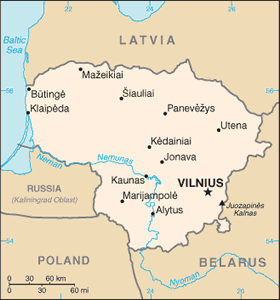The Geography of Lithuania
The Geography of Lithuania
Lithuanian Geography
Location: Eastern Europe, bordering the Baltic Sea, between Latvia and Russia
Geographic coordinates: 56 00 N, 24 00 E
Map references: Europe
Area: total: 65,300 sq km land: NA sq km water: NA sq km
Area - comparative: slightly larger than West Virginia
Land boundaries: total: 1,574 km border countries: Belarus 680 km, Latvia 576 km, Poland 91 km, Russia (Kaliningrad) 227 km
Coastline: 90 km
Maritime claims: territorial sea: 12 nm
Climate: transitional, between maritime and continental; wet, moderate winters and summers
Terrain: lowland, many scattered small lakes, fertile soil
Elevation extremes: lowest point: Baltic Sea 0 m highest point: Juozapines Kalnas 294 m
Natural resources: peat, arable land, amber
Land use: arable land: 44.81% permanent crops: 0.9% other: 54.29% (2005)
Irrigated land: 70 sq km (2003)
Natural hazards: NA
Environment - current issues: contamination of soil and groundwater with petroleum products and chemicals at military bases
Environment - international agreements: party to: Air Pollution, Air Pollution-Nitrogen Oxides, Air Pollution-Persistent Organic Pollutants, Air Pollution-Sulphur 85, Air Pollution-Sulphur 94, Air Pollution-Volatile Organic Compounds, Biodiversity, Climate Change, Climate Change-Kyoto Protocol, Desertification, Endangered Species, Environmental Modification, Hazardous Wastes, Law of the Sea, Ozone Layer Protection, Ship Pollution, Wetlands signed, but not ratified: none of the selected agreements
Geography - note: fertile central plains are separated by hilly uplands that are ancient glacial deposits


